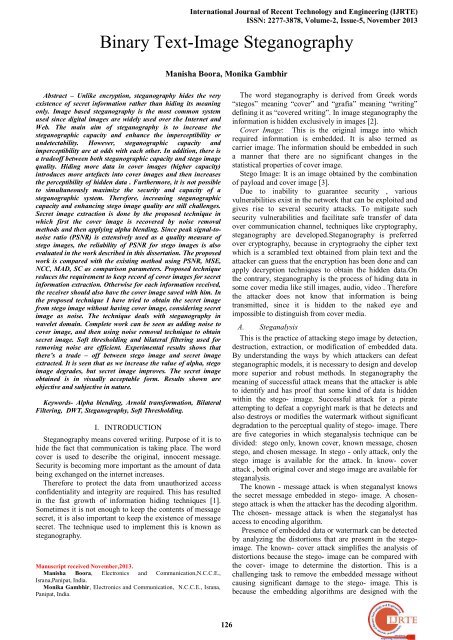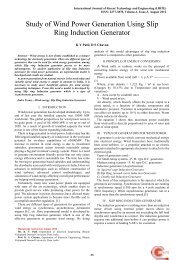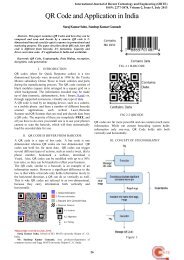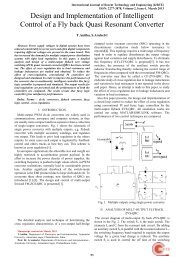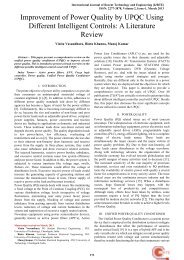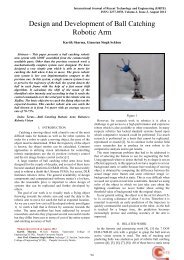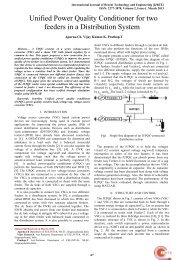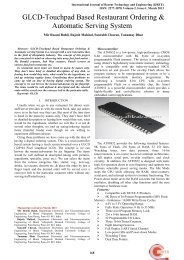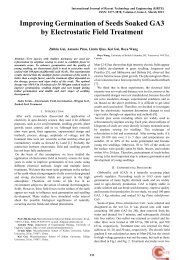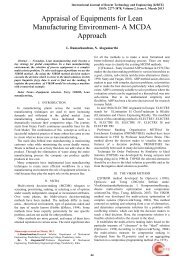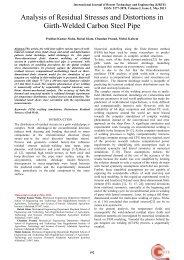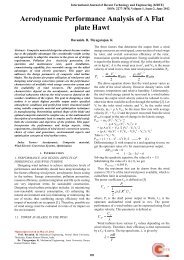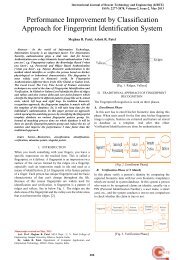Binary Text-Image Steganography - International Journal of Recent ...
Binary Text-Image Steganography - International Journal of Recent ...
Binary Text-Image Steganography - International Journal of Recent ...
Create successful ePaper yourself
Turn your PDF publications into a flip-book with our unique Google optimized e-Paper software.
<strong>International</strong> <strong>Journal</strong> <strong>of</strong> <strong>Recent</strong> Technology and Engineering (IJRTE)ISSN: 2277-3878, Volume-2, Issue-5, November 2013<strong>Binary</strong> <strong>Text</strong>-<strong>Image</strong> <strong>Steganography</strong>Manisha Boora, Monika GambhirAbstract – Unlike encryption, steganography hides the veryexistence <strong>of</strong> secret information rather than hiding its meaningonly. <strong>Image</strong> based steganography is the most common systemused since digital images are widely used over the Internet andWeb. The main aim <strong>of</strong> steganography is to increase thesteganographic capacity and enhance the imperceptibility orundetectability. However, steganographic capacity andimperceptibility are at odds with each other. In addition, there isa trade<strong>of</strong>f between both steganographic capacity and stego imagequality. Hiding more data in cover images (higher capacity)introduces more artefacts into cover images and then increasesthe perceptibility <strong>of</strong> hidden data . Furthermore, it is not possibleto simultaneously maximize the security and capacity <strong>of</strong> asteganographic system. Therefore, increasing steganographiccapacity and enhancing stego image quality are still challenges.Secret image extraction is done by the proposed technique inwhich first the cover image is recovered by noise removalmethods and then applying alpha blending. Since peak signal-tonoiseratio (PSNR) is extensively used as a quality measure <strong>of</strong>stego images, the reliability <strong>of</strong> PSNR for stego images is alsoevaluated in the work described in this dissertation. The proposedwork is compared with the existing method using PSNR, MSE,NCC, MAD, SC as comparison parameters. Proposed techniquereduces the requirement to keep record <strong>of</strong> cover images for secretinformation extraction. Otherwise for each information received,the receiver should also have the cover image saved with him. Inthe proposed technique I have tried to obtain the secret imagefrom stego image without having cover image, considering secretimage as noise. The technique deals with steganography inwavelet domain. Complete work can be seen as adding noise tocover image, and then using noise removal technique to obtainsecret image. S<strong>of</strong>t thresholding and bilateral filtering used forremoving noise are efficient. Experimental results shows thatthere’s a trade – <strong>of</strong>f between stego image and secret imageextracted. It is seen that as we increase the value <strong>of</strong> alpha, stegoimage degrades, but secret image improves. The secret imageobtained is in visually acceptable form. Results shown areobjective and subjective in nature.Keywords- Alpha blending, Arnold transformation, BilateralFiltering, DWT, <strong>Steganography</strong>, S<strong>of</strong>t Thresholding.I. INTRODUCTION<strong>Steganography</strong> means covered writing. Purpose <strong>of</strong> it is tohide the fact that communication is taking place. The wordcover is used to describe the original, innocent message.Security is becoming more important as the amount <strong>of</strong> databeing exchanged on the internet increases.Therefore to protect the data from unauthorized accessconfidentiality and integrity are required. This has resultedin the fast growth <strong>of</strong> information hiding techniques [1].Sometimes it is not enough to keep the contents <strong>of</strong> messagesecret, it is also important to keep the existence <strong>of</strong> messagesecret. The technique used to implement this is known assteganography.Manuscript received November,2013.Manisha Boora, Electronics and Communication,N.C.C.E.,Israna,Panipat, India.Monika Gambhir, Electronics and Communication, N.C.C.E., Israna,Panipat, India.The word steganography is derived from Greek words“stegos” meaning “cover” and “grafia” meaning “writing”defining it as “covered writing”. In image steganography theinformation is hidden exclusively in images [2].Cover <strong>Image</strong>: This is the original image into whichrequired information is embedded. It is also termed ascarrier image. The information should be embedded in sucha manner that there are no significant changes in thestatistical properties <strong>of</strong> cover image.Stego <strong>Image</strong>: It is an image obtained by the combination<strong>of</strong> payload and cover image [3].Due to inability to guarantee security , variousvulnerabilities exist in the network that can be exploited andgives rise to several security attacks. To mitigate suchsecurity vulnerabilities and facilitate safe transfer <strong>of</strong> dataover communication channel, techniques like cryptography,steganography are developed.<strong>Steganography</strong> is preferredover cryptography, because in cryptograohy the cipher textwhich is a scrambled text obtained from plain text and theattacker can guess that the encryption has been done and canapply decryption techniques to obtain the hidden data.Onthe contrary, steganography is the process <strong>of</strong> hiding data insome cover media like still images, audio, video . Thereforethe attacker does not know that information is beingtransmitted, since it is hidden to the naked eye andimpossible to distinguish from cover media.A. SteganalysisThis is the practice <strong>of</strong> attacking stego image by detection,destruction, extraction, or modification <strong>of</strong> embedded data.By understanding the ways by which attackers can defeatsteganographic models, it is necessary to design and developmore superior and robust methods. In steganography themeaning <strong>of</strong> successful attack means that the attacker is ableto identify and has pro<strong>of</strong> that some kind <strong>of</strong> data is hiddenwithin the stego- image. Successful attack for a pirateattempting to defeat a copyright mark is that he detects andalso destroys or modifies the watermark without significantdegradation to the perceptual quality <strong>of</strong> stego- image. Thereare five categories in which steganalysis technique can bedivided: stego only, known cover, known message, chosenstego, and chosen message. In stego - only attack, only thestego image is available for the attack. In know- coverattack , both original cover and stego image are available forsteganalysis.The known - message attack is when steganalyst knowsthe secret message embedded in stego- image. A chosenstegoattack is when the attacker has the decoding algorithm.The chosen- message attack is when the steganalyst hasaccess to encoding algorithm.Presence <strong>of</strong> embedded data or watermark can be detectedby analyzing the distortions that are present in the stegoimage.The known- cover attack simplifies the analysis <strong>of</strong>distortions because the stego- image can be compared withthe cover- image to determine the distortion. This is achallenging task to remove the embedded message withoutcausing significant damage to the stego- image. This isbecause the embedding algorithms are designed with the126
<strong>Binary</strong> <strong>Text</strong>-<strong>Image</strong> <strong>Steganography</strong>assurance that the watermark can only be removed withsignificant damage to the stego- image [4].II. RELATED WORKS .K. Moon et al. [1] implemented 4LSB for color bitmapimages (24 bit and 8 bit i.e. 256 color palette images) andwave files as the carrier media. By using this proposedalgorithm, file <strong>of</strong> any format can be hidden in an image andaudio file.T. Morkel et al. [2] attempts to identify therequirements <strong>of</strong> a good steganographic algorithm andreflects on which steganographic techniques are moresuitable for which applications.K Suresh Babu* et al. [3] proposed Steganographicmodel Authentication <strong>of</strong> Secret Information in <strong>Image</strong><strong>Steganography</strong> that can verify the reliability <strong>of</strong> theinformation being transmitted to the receiver. The methodcan verify whether the attacker has tried to edit, delete orforge the secret information in the stego-image. The methodcan verify whether each row has been modified or forgedby the attacker.Eugene T. Lin et al. [4] reviewed various techniques fordata hiding in digital images. Features <strong>of</strong> steganographicsystems were also discussed. Finally, an overview <strong>of</strong>steganalysis was presented.S.Arivazhagan1 et al. [5] The work deals with <strong>Image</strong>steganalysis which focuses first in identifying the employedsteganographic algorithm and this information is used indeciphering any hidden data in cover images. In this workthe stego images are decomposed into its approximation anddetail sub bands and from the decomposed sub bands, cooccurrenceand statistical features are derived. This leads todetection <strong>of</strong> steganographic algorithm.Zhenjun Tang et al. [10] designed an image encryptiontechnique by combining Arnold transform and three randomstrategies . The security <strong>of</strong> the scheme depends on therandom strategies.. The proposed encryption scheme isrobust and secure. It has no size limitation, indicating theapplication to any size images.<strong>of</strong> the LL sub- band continues until the desired number <strong>of</strong>levels determined by the application is reached. Whenimage is passed through a series <strong>of</strong> low pass and high passfilters, image is decomposed into sub- bands <strong>of</strong> differentresolutions. At level 1 DWT decomposes image into fournon- overlapping multiresolution sub- bands : LL X(Approximate sub- band), LH X (Vertical sub- band), HL X(Horizontal sub- band), HH X ( Diagonal sub- band). HereLL X is low frequency component, whereas LH X , HL X , HH Xare high frequency components. Maximum energy <strong>of</strong>images is concentrated in approximate sub-band andamplitude <strong>of</strong> coefficient is larger than the one <strong>of</strong> detail subgraph.High frequency sub- bands <strong>of</strong> the wavelet transforminclude edges and textures, and other detailed information <strong>of</strong>the image and the human eye is not very sensitive tochanges in such bands. Embedding is difficult to be detectedin these parts, but it is easy to be destroyed and has poorstability after image processing.To obtain next scale <strong>of</strong> wavelet coefficients after level 1,the sub- band LL 1 is further decomposed until final N scaleis reached. When N is reached, there are 3N+1 sub- bandsavailable where ‘x’ ranges from 1 to N. From these DWTcoefficients, original image can be reconstructed. Thisreconstruction process is called inverse DWT (IDWT).Fig. 1: Three Level <strong>Image</strong> DecompositionIII. PROPOSED METHODA. Discrete wavelet transformDiscrete Wavelet Transform provides a fast, local, sparse,multi-resolution analysis <strong>of</strong> real world signals and images.It is useful for processing non-stationary signals. Itdecomposes signal into a set <strong>of</strong> basis functions, calledwavelets. Wavelets are created by translations and dilations<strong>of</strong> a fixed function called mother wavelet.Wavelet transform provides both frequency and spatialdescription <strong>of</strong> an image. Unlike conventional Fouriertransform, temporal information is retained in thistransformation process. The main idea behind DWT resultsfrom multi-resolution analysis, which involvesdecomposition <strong>of</strong> an image in frequency channels <strong>of</strong>constant bandwidth on logarithmic scale. <strong>Image</strong> itself isconsidered as a two dimensional signal. DWT can beimplemented as a multistage transformation. An image isdecomposed into four sub- bands denoted as LL (Low-Low), LH (Low- High), HL (High- Low), HH (High-High) at level 1 in DWT domain. LL sub- band consists <strong>of</strong>low frequency wavelet coefficientsThe LL sub- band can further be decomposed to obtainanother level <strong>of</strong> decomposition. The decomposition processFig. 2: One level decomposition using two dimensionalDWTLPF1 represents low pass filtering <strong>of</strong> image rows, HPF1represents high pass filtering <strong>of</strong> image rows, LPF2represents low pass filtering <strong>of</strong> image columns, HPF2represents high pass filtering <strong>of</strong> image columns.Fig. 3: <strong>Image</strong> Recomposition127
<strong>International</strong> <strong>Journal</strong> <strong>of</strong> <strong>Recent</strong> Technology and Engineering (IJRTE)ISSN: 2277-3878, Volume-2, Issue-5, November 2013Union <strong>of</strong> four sub- bands permits to reconstruct the originalimage. The LL subband comes from low pass filtering inboth directions and is mostly like original image and so it iscalled as approximate component. The remaining sub-bandscomes from the combination <strong>of</strong> low and high pass filter.Components obtained using only high pass filters are calledas detailed components. LH preserves vertical edge details,HL preserves horizontal edge details and HH preserves thediagonal details [5][6][7].B. Arnold transformThe image encryption algorithms can be classified into twokinds: One is; frequency-based method the other is spatialbasedmethod. The spatial-based algorithms are generallyachieved by altering pixel values or swapping the pixelpositions. Arnold transform commonly known as cat facetransform is an efficient technique for position swapping,and widely applied to image encryption. Encryptiontechniques also called image scrambling, produces anunintelligible or disordered image from the original image,therefore used to confirm the security and improve therobustness <strong>of</strong> the steganographic scheme. Therefore thesecret image should be pre-processed before embedded intothe original image. The transform rearranges the position <strong>of</strong>image pixels, and if it is done several times, a disorderedimage can be generated. The special property <strong>of</strong> ArnoldTransform is that image comes to it’s original state aftercertain number <strong>of</strong> iterations i.e. after iterating a certainnumbers it returns the same pixels position as before andthereby produces the original image. . These’ number <strong>of</strong>iterations’ are called ‘Arnold Period’ or ‘Periodicity <strong>of</strong>Arnold Transform’. The periodicity <strong>of</strong> Arnold Transform(P), is dependent on size <strong>of</strong> given image.It is a one-to-one transformation applied on an image<strong>of</strong> dimensions N×N, represented by the equationmod N(x , y) and (x’ , y’) {0, 1, 2, ………………..N-1}where, A=The above equation rearranges each and every pixelcoordinates <strong>of</strong> the images i.e. realigns the pixel matrix <strong>of</strong>digital image, where (x, y) is the location coordinates <strong>of</strong>the original image pixels and (x’, y’) is the locationcoordinates <strong>of</strong> image pixels that after transform. When allthe coordinates are transformed, the image we obtain isscrambled image. N is the height or width <strong>of</strong> the squareimage processed.N 2 3 4 5 6 7 8 9 1 1 1 1 2 2Period3 4 3 10N 3 4 4 52 0 8 0Period2430121501256248 6 126 6 10 4 0060480301201 25 121 12 25 8Fig 4. Relation between size <strong>of</strong> image and periodFigures below represent the Arnold transform processwith 8×8 image. In Figure 5, Figure 5a is the original image,with its matrix message in Figure 5b, and Figure 5c-5h showthe matrix message from one to six-time Arnold transform.1506025096612256192412480120550512384(e)(g)(a)(b)(b)(d)(f)(h)Fig. 5: Arnold transform process with 8×8 image(a) (b) (c) (d)Fig. 6: <strong>Image</strong> before 20(60, 96) time Arnold transform withcut original imageFigure 6a is the 128×128 original image. Fig. 6(b)-(d)shows the image thorough 20/60/96 times Arnold transform.Arnold transform based schemes have a common weaknessthat image height must equal image width.If one image iterates m steps to get scrambled state withArnold transformation, it can restore its image with the samesteps form the scrambled state by anti-Arnoldtransformation [8-13].C. Alpha BlendingIt is the way <strong>of</strong> mixing two images together to form astego image. In this technique the decomposed components<strong>of</strong> the host image and the secret image are multiplied by ascaling factor and are added. It can be accomplished byblending each pixel from the secret image with thecorresponding pixel in the cover image. The equation forexecuting alpha blending is as follows,Stego <strong>Image</strong> = k*(LL3) +q*(Secret <strong>Image</strong>) where, k andq are scaling factorsThe blending factor used in the blended image is calledthe "alpha."Formula <strong>of</strong> the alpha blending extraction to Recoversecret image is given bySecret <strong>Image</strong> = (Stego <strong>Image</strong> – Cover <strong>Image</strong>) /q [14-15].128
<strong>Binary</strong> <strong>Text</strong>-<strong>Image</strong> <strong>Steganography</strong>D. ImplementationThe following session describes the implementation <strong>of</strong>the encoding and decoding process clearly. The encodingprocess includes DWT, Arnold transformation, Alphablending, IDWT and Stego image formation. The decodingprocess includes DWT, Arnold transformation, Alphablending, IDWT and Secret image formation.1. Decoding Process1. Encoding ProcessDuring encoding process the cover image and scrambledsecret image(i.e. with key) are DWT transformed and thenalpha blended. Next, IDWT was performed to reform thestego image.This secure stego image was transferrred to anycommunication media. The secret key and alpha blendingoperation gives more security.Fig. 8: Decoding process (Proposed Work)Fig. 7: Encoding process(Existing Work)1. Preprocessing both the cover image(N*N)and secret image(N*N).2. Perform 2-D discrete wavelet transform(DWT) <strong>of</strong> coverimage(N*N).3. Apply private key with Arnold transformation on secretimage and get the scrambled secret image(scramblingprovides security and applying key further increases thesecurity level).4. Perform 2-D DWT <strong>of</strong> the secret image image(N*N).5. Extract the approximation co-efficient <strong>of</strong> matrix(LL)and detail coefficient matrices LH, HL& HH <strong>of</strong> coverimage.6. Next extract the approximation co-efficient <strong>of</strong> matrixLL and detail coefficient matrices LH, HLand HH <strong>of</strong>the scrambled image.7. Apply alpha blending on cover image and secret image.8. Perform 2-D IDWT (Inverse discrete wavelettransform) to form stego image.1. Receive the stego image.2. Perform 2-D DWT on the stego image and obtainfrequency components LL, LH, HL, HH.3. Pass approximate coefficient LL through bilateral filterand perform s<strong>of</strong>t thresholding on other detailedcoefficients.4. Synthesize the outputs after performing bilateralfiltering and s<strong>of</strong>t thresholding and obtain required coverimage.5. Perform DWT on recovered cover image and stegoimage.6. Apply alpha blending on wavelet transformed stegoimage and cover image.7. Take IDWT to obtain scrambled image.8. Perform Arnold Transformation with key and get theoriginal secret image.IV. EXPERIMENTAL RESULTS ANDPERFORMANCE ANALYSISImplementation <strong>of</strong> the proposed method has been doneusing Matlab R2007a.Experimental Design: Mainly, five grayscale images:Lena, Barbara, Goldhill, Peppers,each <strong>of</strong> 256x256 pixelswere arbitrarily selected, Barbara is originally taken <strong>of</strong> size512x512 pixels and used as cover images. All the imagesare resized to 512x512. However, the only reason forchoosing these images is being well-known and commonlyused in the areas <strong>of</strong> digital image processing, compressionand steganography. Additionally, the variables used toevaluate the performance <strong>of</strong> proposed method are PSNR,NCC, MSE, MD, SC. The experimental results are for onlybinary text images (secret images). Bayes Shrink is used fors<strong>of</strong>t thresholding.129
<strong>International</strong> <strong>Journal</strong> <strong>of</strong> <strong>Recent</strong> Technology and Engineering (IJRTE)ISSN: 2277-3878, Volume-2, Issue-5, November 2013COVER IMAGETABLE-ICOMPARISON OF VARIOUS QUALITY MEASUREMENTSSECRETIMAGEPSNR MSE NCC MD S CALPHA1) Lenna.tiff256×256<strong>Image</strong>1.bmp403×32724.51165.5228e+0070.9093 5.6843e-014 0.8285 0.062) Barbara.png512×512Name.bmp403×32724.80255.2500e+0070.9129 5.6843e-014 0.8357 0.063) Goldhill.tiff256×256<strong>Image</strong>2.bmp403×32724.78385.2727e+0070.9069 5.6843e-014 0.8248 0.064) Peppers.tiff256×256 <strong>Image</strong>3.jpeg400×32524.55105.1200e+0070.9158 5.6843e-0140.84090.065) Lenna.tiff256×256 <strong>Image</strong>1.bmp403×32730.53221.3807e+0070.95302.8422e-0140.90870.036) Barbara.png512×512Name.bmp403×32730.82311.3125e+007 0.9551 7.1054e-014 0.91300.037) Goldhill.tiff256×256 <strong>Image</strong>2.bmp403×32730.80441.3182e+0070.95182.8422e-0140.90670.038) Peppers.tiff256×256 <strong>Image</strong>3.jpeg400×32530.57161.2800e+0070.9567 5.6843e-0140.91590.03SUBJECTIVE RESULTS:Extracted Secret <strong>Image</strong>(Proposed Technique)Extracted Secret <strong>Image</strong>(Existing Technique)130
<strong>Binary</strong> <strong>Text</strong>-<strong>Image</strong> <strong>Steganography</strong>V. CONCLUSION AND FUTURE WORKIn the proposed technique it is tried to obtain the secretimage from stego image without having cover image,considering secret image as noise. Complete work can beseen as adding noise to cover image, and then using noiseremoval technique to obtain secret image. This work dealswith secret images as binary text images, with textparticulary to be black. Experimental results shows thatthere’s a trade – <strong>of</strong>f between stego image and secret imageextracted. It is seen that as we increase the value <strong>of</strong> alpha,stego image degrades but the secret image becomes morevisually acceptable. The information retrieved is <strong>of</strong> visuallyacceptable form. Proposed technique reduces therequirement to keep record <strong>of</strong> cover images for secretinformation extraction. Otherwise for each informationreceived, the receiver should also have the cover imagessaved with him, which he should recall everytime for eachinformation extraction. Although the results obtained withprevious technique were better, but the proposed techniquealso fulfills the requirement <strong>of</strong> a steganographic system,with a large advantage over it. In addition, there is a trade<strong>of</strong>fbetween both steganographic capacity and stego imagequality. Hiding more data in cover images (higher capacity)introduces more artefacts into cover images and thenincreases the perceptibility <strong>of</strong> hidden data . Furthermore, itis not possible to simultaneously maximize the security andcapacity <strong>of</strong> a steganographic system. Therefore, increasingsteganographic capacity and enhancing stego image qualityare still challenges. Future Work: Experiments can be donefor secret images not particulary be text. The work can beextended for color images. One can further try to improvethe extracted secret image quality.[10] Divya saxena,” Digital Watermarking Algorithm based on SingularValue Decomposition and Arnold Transform”, <strong>International</strong> <strong>Journal</strong><strong>of</strong> Electronics and Computer Science Engineering, pp. 22- 27.[11] Lingling Wu, Jianwei Zhang, Weitao Deng, Dongyan He,” ArnoldTransformation Algorithm and Anti-Arnold TransformationAlgorithm”, The 1st <strong>International</strong> Conference on InformationScience and Engineering (ICISE2009), pp. 1164- 1167, IEEE 2009[12] B.L. Gunjal, R.R.Manthalkar,” Discrete Wavelet Transform basedStrongly Robust Watermarking Scheme for Information Hiding inDigital <strong>Image</strong>s”, Third <strong>International</strong> Conference on Emerging Trendsin Engineering and Technology, pp. 124- 129, IEEE 2010.[13] Kalra, G.S., R. Talwar and H. Sadawarti,” Blind Digital <strong>Image</strong>Watermarking Robust Against Histogram Equalization”, <strong>Journal</strong> <strong>of</strong>Computer Science 8 (8), pp. 1272- 1280, 2012.[14] Baisa L. Gunjal, and Suresh N.Mali,” Secured Color <strong>Image</strong>Watermarking Technique in DWT- DCT Domain”, <strong>International</strong><strong>Journal</strong> <strong>of</strong> Computer Science, Engineering and InformationTechnology (IJCSEIT), Vol.1, No.3, pp. 36- 44, August 2011.[15 Nilanjan Dey, Sourav Samanta, Anamitra Bardhan Roy,” A NovelApproach <strong>of</strong> <strong>Image</strong> Encoding and Hiding using Spiral Scanning andWavelet Based Alpha-Blending Technique”, Int. J. Comp. Tech.Appl., Vol. 2 (6), pp. 1970-1974, 2011.Manisha Boora received the B.Tech degree inElectronics and Communcation from Lingaya’sInstitute <strong>of</strong> Management and Technology,Faridabad, affiliated to Maharshi DyanandUniversity, Rohtak, India in 2011. She is persuingM.Tech in Electronics and Communication, fromN.C. College <strong>of</strong> Engineering,Panipat, India. Herarea <strong>of</strong> interest is <strong>Image</strong> Processing.Monika Gambhir received the M.Tech degreein Electronics and Communcation from N.C.College <strong>of</strong> Engineering, Panipat, India.She isworking as Assistant Pr<strong>of</strong>essor there. Her area <strong>of</strong>interest is Digital <strong>Image</strong> Processing.REFERENCES[1] S .K. Moon and R.S. Kawitkar, “Data Security using Data Hiding”,<strong>International</strong> Conference on Computational Intelligence andMultimedia Applications, vol.- 04, pp. 247-251, Dec. 2007.[2] T. Morkel, J.H.P. El<strong>of</strong>f, M.S. Olivier, “An Overview <strong>of</strong> <strong>Image</strong><strong>Steganography</strong>”, Information and Computer Security Architecture(ICSA) Research Group Department <strong>of</strong> Computer Science, 2005[3] K Suresh Babu* et. al., “Authentication <strong>of</strong> Secret Information in<strong>Image</strong> <strong>Steganography</strong>”, pp. 1-6, Nov. 2008, IEEE .[4] Eugene T. Lin and Edward J. Delp,” A Review <strong>of</strong> Data Hiding inDigital <strong>Image</strong>s”.[5] S.Arivazhagan,W.Sylvia Lilly Jebarani,, M.Shanmugaraj,”AnEfficient Method for the Detection <strong>of</strong> Employed SteganographicAlgorithm using Discrete Wavelet Transform”, Second <strong>International</strong>conference on Computing, Communication and NetworkingTechnologies, pp.1-6, 2010.[6] Chih-Chin Lai,Member, and Cheng-Chih Tsai,” Digital <strong>Image</strong>Watermarking Using Discrete Wavelet Transform and SingularValue Decomposition”, Ieee Transactions on Instrumentation andMeasurement, Vol. -59, No. -11, pp. 3060- 3063, November 2010.[7] B.L. Gunjal, R.R.Manthalkar,” Discrete Wavelet Transform basedStrongly Robust Watermarking Scheme for Information Hiding inDigital <strong>Image</strong>s”, Third <strong>International</strong> Conference on Emerging Trendsin Engineering and Technology, pp. 124- 129, 2010 IEEE.[8] Ma Ding, Fan Jing,” Digital <strong>Image</strong> Encryption Algorithm Ba sed onImproved Arnold Transform”, <strong>International</strong> Forum on InformationTechnology and Applications, Vol. -1, pp. 174- 176, 2010.[9] Sudhir Keshari, Dr. S. G. Modani,” <strong>Image</strong> Encryption Algorithmbased on Chaotic Map Lattice and Arnold cat map for SecureTransmission”, <strong>International</strong> <strong>Journal</strong> <strong>of</strong> Computer Science andTechnology(IJCST), Vol.- 2, Issue - 1, March 2011[10] Zhenjun Tang and Xianquan Zhang,” Secure <strong>Image</strong> Encryptionwithout Size Limitation Using Arnold Transform and RandomStrategies”, <strong>Journal</strong> <strong>of</strong> Multimedia, Vol.- 6, No.- 2, pp. 202- 206,April 2011.131


